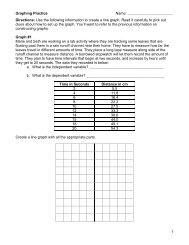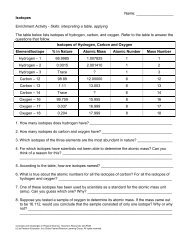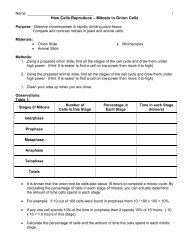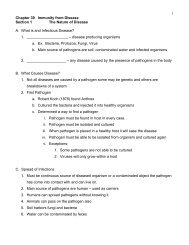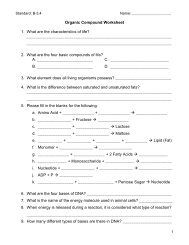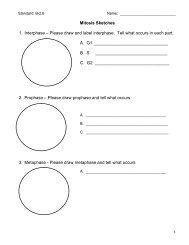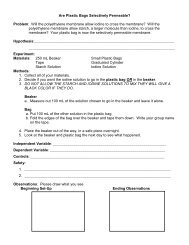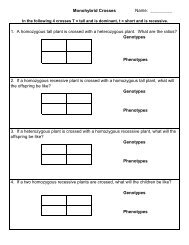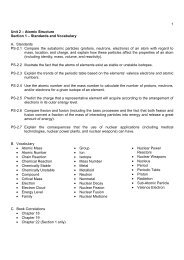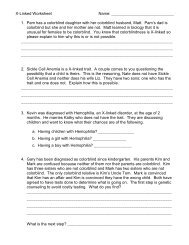Chapter 15
Chapter 15
Chapter 15
Create successful ePaper yourself
Turn your PDF publications into a flip-book with our unique Google optimized e-Paper software.
<strong>Chapter</strong> <strong>15</strong><br />
Section 1<br />
The Theory of Evolution<br />
Natural Selection and the Evidence of Evolution<br />
1<br />
A. Charles Darwin & Natural Selection<br />
• To understand many of the fields of biology you must understand evolution.<br />
1. ______________________________________________<br />
a. 1831, age 21, Darwin took a job as a naturalist on the HMS Beagle. This<br />
was a ship whose purpose was to chart and map South America and the<br />
South Pacific.<br />
b. His job was to collect, study and store biological specimens collected.<br />
c. _________________________________________<br />
i. Small group of islands about 100 km from S.A.<br />
ii. Darwin studied reptiles, insects, birds and flowering plants unique to the<br />
islands, but similar to the rest of the world.<br />
iii. He saw differences between the islands themselves<br />
d. England<br />
i. When Darwin finished his 5 yr voyage he returned to England and<br />
studied his collections and conducted experiments.<br />
ii. He decided from his research that a “Struggle for Existence” occurred<br />
and only those best suited survived.<br />
a. _____________ d. __________________<br />
b. _____________ e. __________________<br />
c. _____________<br />
iii. Darwin believed only the strongest individuals would survive and<br />
reproduce.<br />
iv. Pigeon Experiments showed Darwin that pigeons with desirable<br />
characteristics would survive and pass on their traits.<br />
v. ________________________ – when a breeder selects the desired<br />
traits and breeds for those traits<br />
e. Natural Selection<br />
i. This was Darwin’s Theory<br />
ii. ___________________________ – is a mechanism for change in<br />
populations that occurs when an organism with the desired traits for<br />
environment, survival, reproduction and then are able to pass these<br />
traits to the next generation – known as “Survival of the Fittest”<br />
iii. Humans - Eating<br />
a. ______________________________<br />
b. ______________________________<br />
c. ______________________________<br />
d. ______________________________<br />
iv. Birds – Drinking<br />
a. Only had small holes in the ground to drink out of<br />
b. Only birds with beaks that fit in the holes will survive and live<br />
to reproduce
v.1850’s – On the Origin of Species<br />
a. Convinced many scientists of evolution<br />
b. Came under intense fire from the church<br />
2<br />
B. Natural Selection and Adaptations<br />
1. __________________________________<br />
a. Mole Rats<br />
i. At one time they live above ground<br />
ii. They had characteristics of the African Rock Rat and over time they<br />
developed large teeth and claws. This allowed the mole rats to dig<br />
deeper holes to get away from predators. The mole rats with the<br />
adaptations survived and then passed on their traits.<br />
b. Many animals develop structural adaptations to better survive<br />
c. Structural adaptations may begin but take years and years to develop<br />
d. ________________________________<br />
i. Use to have white moths but the industrial revolution caused pollution.<br />
The white moths would get eaten very quickly on the tress. The moths<br />
that were darker did better and over time they survive and pass on the<br />
trait to their offspring.<br />
2. Physiological Adaptations<br />
a. 50 years ago Penicillin was discovered and used to kill many of the<br />
bacteria that plagued people.<br />
b. Scientists believe the bacteria have adapted and therefore this is why<br />
penicillin is not as effective.<br />
c. Other Ex: Weeds & Insects<br />
C. Evidence of Evolution<br />
1. __________________________________<br />
a. Fossils help to give a history of many organisms<br />
b. There are pieces missing and scientists hypothesize about these gaps; so<br />
every step in evolution is not exact<br />
2. ____________________________________<br />
a. ______________________________ – structures having a common<br />
evolutionary origin; They have a similar structure and function but this<br />
does not mean the organisms themselves are related.<br />
i. Ex: Forearms in bats and humans<br />
b. _____________________________– structures without a common<br />
evolutionary origin that are similar in structure but not in function; This can<br />
be used to indicate evolutionary relationships but do show evidence.<br />
i. Ex: Wing of insect and bird
3. ____________________________________<br />
a. _______________________– any body structure that is reduced in<br />
function in a living organism but many have been used in an ancestor.<br />
3<br />
b. These structures become vestigial because of changes in the behavior of<br />
the organism.<br />
c. As the organism continues to pass on traits the organ shrinks in size,<br />
stops functioning and may disappear.<br />
d. Ex: Appendix in Humans<br />
Eyes of Mole Rats<br />
4. _________________________________<br />
a. Embryos all start out somewhat the same.<br />
b. As they form they develop their own structures and functions<br />
c. As a embryo all vertebrates possess some of the same characteristics<br />
i. ___________________________<br />
ii. ___________________________<br />
iii. ___________________________<br />
5. ________________________________<br />
a. If scientists compare DNA of different organisms the DNA can be<br />
compared.<br />
b. Organisms that are closer together in ancestry have more similar DNA<br />
c. Recently, scientists have been using RNA to compare organisms<br />
<strong>Chapter</strong> <strong>15</strong><br />
Section 2<br />
The Theory of Evolution<br />
Mechanisms of Evolution<br />
A. Population Genetics & Evolution<br />
• When Darwin developed his theory of Natural Selection he did so without considering<br />
the gene and its power.<br />
1. Populations Evolve, Individuals Do Not<br />
a. If an individual organism possesses a phenotype that is not adapted to the<br />
environment it may result in the individual’s inability to successfully<br />
compete.<br />
b. In one lifetime, new features cannot evolve in response to natural selection.<br />
If must occur on the entire population over many generations.<br />
c. ___________________ – the entire collection of genes among a population<br />
d. _________________ – the percentage of a particular allele in a gene pool
e. ________________________ – a population in which the frequency of<br />
alleles does not change from generation to generation<br />
4<br />
f. Allelic frequency can change due to natural selection. When this occurs the<br />
genetic equilibrium is disrupted.<br />
2. Changes in Genetic Equilibrium<br />
a. A population in genetic equilibrium is not evolving, it is still. No new traits<br />
are gained or lost.<br />
b. What disrupts genetic equilibrium?<br />
1. _____________________________<br />
2. _____________________________<br />
3. Movement of other organisms into or out of the environment<br />
4. Movement of same species out (gene pool lost) or into the<br />
environment (gene pool gains).<br />
c. The greatest impact on genetic equilibrium is natural selection – it allows<br />
you to lose bad alleles and keep the good ones.<br />
d. __________________ – altercation of allelic frequency by chance events<br />
1. __________________________________________<br />
3. Natural Selection Acts on Variations<br />
a. The result of natural selection is that some members of the population are<br />
more likely to pass on their genes than others.<br />
b. __________________ – selection favoring average individuals, resulting in<br />
the decline of variation in a population<br />
i. Ex: Spiders<br />
a. Average Size Spiders survive the best<br />
b. Too Big – Seen by predators<br />
c. Too Small – Not able to catch enough prey to survive<br />
c. __________________________ – one of the extreme forms of a trait is<br />
favored; can lead to rapid evolution of a population<br />
i. ______________________________<br />
a. A breed of deep tree dwelling insects come into an area<br />
b. Only the woodpeckers with long beaks could get to the<br />
insects to eat.<br />
d. __________________________ – selection favoring individuals at both<br />
extremes of a trait, can lead to the evolution of a new species<br />
i. Limpets (Marine Organisms)<br />
a. Shell color varies from white to dark brown<br />
b. Limpets live on rocks the same color to camouflage<br />
themselves so birds do not prey on them<br />
c. White Limpets – Live on White Rocks<br />
d. Dark Limpets – Live on Dark Rocks<br />
e. Tan Limpets – Neither – They get Eaten
B. The Evolution of Species<br />
• ______________________________ – the evolution of a new species<br />
1. Physical Barriers<br />
a. In the natural world, physical barriers will form and break up the large<br />
populations into smaller ones.<br />
5<br />
b. ____________________________ – occurs if a physical barrier separates<br />
a population into groups<br />
1. __________________________<br />
2. __________________________<br />
3. __________________________<br />
4. __________________________<br />
5. __________________________<br />
c. Geographic isolation is one way that a new species can form. Over time<br />
from being separated they adapted to their local environment through<br />
natural selection.<br />
d. Even the gene pools will become different and over time they will change so<br />
much they become a new species<br />
e. Ex: Green Tree Frogs – drought caused them to separate<br />
2. Reproductive Isolation<br />
a. When geographical isolation occurs, gene pools become closed because<br />
no organisms come in or leave.<br />
b. As populations become more distinct reproductive isolation occurs.<br />
c. _____________________n – occurs when formerly interbreeding<br />
organisms are prevented from producing fertile offspring<br />
1. Can occur when genetic material becomes so different that mistakes<br />
occur.<br />
2. Seasonal – mate at different times<br />
3. Chromosomal Abnormalities<br />
a. _______________________ – any species with a multiple of the normal<br />
set of chromosomes.<br />
1. Usually from a mistake in meiosis<br />
2. Fastest form of speciation because it automatically results in<br />
reproductive isolation.<br />
3. When a polyploid individual mates with a normal individual the<br />
zygote has difficulty forming.<br />
4. Usually reserved for plants
4. ________________________ – Can be fast or slow<br />
a. Gradualism – the idea that species originate thru a gradual buildup of new<br />
adaptations<br />
1. Slow and steady<br />
2. Supported by fossil records<br />
b. ____________________________ – speciation occurs in rapid burst<br />
between long periods of stability<br />
1. Requires genetic equilibrium<br />
2. Rapid change in genetics<br />
3. Supported by fossil records<br />
c. Controversy –<br />
1. Many agree that speciation can be fast of slow depending on<br />
conditions in the environment.<br />
5. How does Speciation Occur?<br />
a. Geographical Isolation<br />
b. Reproductive Isolation<br />
c. Chromosomal Abnormalities<br />
C. Patterns of Evolution<br />
• Species Diversify in New Environments<br />
a. ___________________ – process of evolution in which ancestral species<br />
can develop into an array of species that will fit into different niches.<br />
b. Ex: Hawaiian Islands – Honey Creepers<br />
1. Birds are similar in size and shape but differ in colors and beak<br />
shape. The beak shape determines the type of insect the bird will<br />
eat.<br />
c. ____________________________ – evolution in which highly distinctive<br />
species were once similar to an ancestral species<br />
1. Begins when species begin to adapt to different environmental<br />
conditions and change becoming less and less alike<br />
• Distant Species Can Evolve Similar Features<br />
a. _______________________ – evolution of similar traits in distantly<br />
related organisms resulting from adaptations to similar environments.<br />
1. Fish & Dolphins – streamline shape due to water<br />
6



